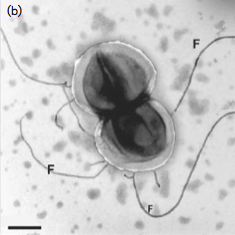Methanosphaerula palustris: Difference between revisions
| Line 2: | Line 2: | ||
==Classification== | ==Classification== | ||
Domain (archaea); Phylum (euryarchaeota); Class (methanomicrobia); Order (methanomicrobiales); | Domain (archaea); Phylum (euryarchaeota); Class (methanomicrobia); Order (methanomicrobiales); most similar to the family Methanospirillaceae | ||
===Species=== | ===Species=== | ||
Revision as of 06:28, 14 April 2012
Classification
Domain (archaea); Phylum (euryarchaeota); Class (methanomicrobia); Order (methanomicrobiales); most similar to the family Methanospirillaceae
Species
|
NCBI: Taxonomy |
Genus species
Description and Significance
Methanosphaerula palustris is a novel archeal species arising from research conducted through Cornell University in 2009. This research reported detailed information regarding the species' phylogenetic placement, physiology/morphology, and habitat from which it was isolated. Researchers utilized culture, microscopy, and molecular based techniques to describe the species' characteristics [1].
Researchers isolated this species from a rich, minerotrophic fen in New York state in 2008. M. palustris was cultured using a modified PM1 medium which is used for culturing anaerobic organisms such as this one. While growing at a range of pH values, a pH of 5.7 was determined to be optimal for growth. Preferred temperatures for growth were optimal at 30 degrees C.
Genome Structure
Describe the size and content of the genome. How many chromosomes? Circular or linear? Other interesting features? What is known about its sequence?
Cell Structure and Metabolism
The cells of the regular cocci, Gram-positive Archaea are mostly associated in pairs, 0.5-0.8 mm in size. While multiple flagella are grown with 14 nm thick and 8–12 mm length, they are readily lost under stress conditions such as high-speed centrifugation and oxic environments. Cell wall of the cells about 30–70 nm thick can be observed in thin sections under electron microscopy. As is shown in study, cell wall can be resistant to SDS lysis, which indicates the cell wall is different from a single S-layer in spite of the fact that the S-layer is the only cell wall component in Archaea [2].
Methane is not produced from ethanol, methanol, 2-propanol, trimethylamine, 2-butanol, acetate, propionate or sodium butyrate, only using H2/CO2 or formate as substrates for methanogenesis in the strictly anaerobic condition. Na2S is used as a sulfur source. Growth will be inhibited with formate concentrations above 50 mM or Na2S concentrations above 0.1 mM.
Ecology and Pathogenesis
Habitat; symbiosis; biogeochemical significance; contributions to environment.
If relevant, how does this organism cause disease? Human, animal, plant hosts? Virulence factors, as well as patient symptoms.
References
[1]Hinsby Cadillo-Quiroz, Joseph B. Yavitt and Stephen H. Zinder. 2009. Methanosphaerula palustris gen. nov., sp. nov., a hydrogenotrophic methanogen isolated from a minerotrophic fen peatland. International Journal of Systematic and Evolutionary Microbiology 59: 928–935.
[2]Wikipedia http://en.wikipedia.org/wiki/S-layer
Author
Page authored by _____, student of Prof. Jay Lennon at Michigan State University.
<-- Do not remove this line-->

